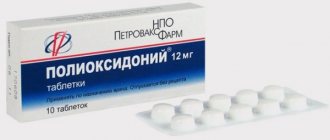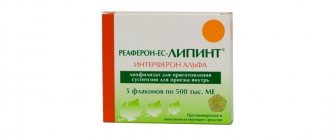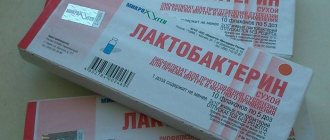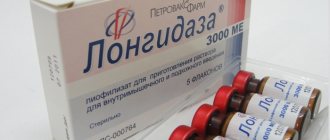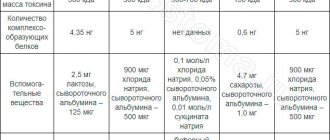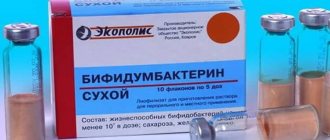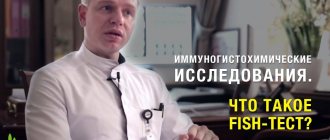Polyoxidonium: at what age can it be given to children?
Polyoxidonium is prescribed to children who have reached the age of six months. It is from this age that, according to the instructions, the drug is allowed to be given to children. But it is worth considering that before using any medications you should discuss this with your doctor. He will take into account individual intolerance and the possibility of an allergic reaction.
Polyoxidonium for children
Polyoxidonium price, where to buy
The average price of Polyoxidonium tablets is 540 UAH. The price of Polyoxidonium 12 mg suppositories is 750 UAH, you can buy 6 mg suppositories for an average of 580 UAH. Price of Polyoxidonium in ampoules (6 mg injections) - from 600 to 1200 UAH.
You can buy 12 mg tablets in Moscow for an average of 660-750 rubles. The price of 6 mg ampoules is from 950 rubles. 6 mg suppositories cost approximately 750 rubles, 12 mg suppositories cost 850 rubles.
- Online pharmacies in RussiaRussia
- Online pharmacies in KazakhstanKazakhstan
ZdravCity
- Polyoxidonium suppositories for vaginal.
and rectal. input 6 mg 10 pcs. Petrovax Pharm NPO LLC 986 rub. order - Polyoxidonium suppositories for vaginal. and rectal. input 12 mg 10 pcs. Petrovax Pharm NPO LLC
RUB 1,181 order
- Polyoxidonium liof. for prig solution for in. and local approx. 6mg vial. 5 pcs. Petrovax Pharm NPO LLC
RUB 1,359 order
- Polyoxidonium tablets 12 mg 10 pcs. Petrovax Pharm NPO LLC
RUR 793 order
Pharmacy Dialogue
- Polyoxidonium suppositories 6 mg No. 10Petrovax Pharm NPO LLC
1007 rub. order
- Polyoxidonium suppositories 12 mg No. 10Petrovax Pharm NPO LLC
1115 rub. order
- Polyoxidonium tablets 12 mg No. 10Petrovax Pharm NPO LLC
RUB 836 order
- Polyoxidonium (vial 0.006g No. 5) Petrovax Pharm NPO LLC
RUB 1,332 order
- Polyoxidonium tablets 12 mg No. 10Petrovax Pharm NPO LLC
RUR 839 order
show more
Polyoxidonium suppositories for children 3 mg and 6 mg - instructions for use
Candles are prescribed to children from the age of six. For such children, a dosage of 6 mg is considered convenient. The medicine is used rectally, that is, for introduction into the anus.
Ways to use candles:
- The suppository is placed at night, after a cleansing enema or after bowel movements have occurred naturally.
- In just one day you need to administer one candle
- The medicine is administered every day for three days.
- Then the candles are used every other day, in a course of 10-20 candles
Polyoxidonium suppositories
Compound
One tablet of Polyoxidonium contains 12 mg of the active substance azoximer bromide , as well as potato starch (Amylum solani), lactose monohydrate (Lactose monohydrate), stearic acid (Acidum stearicum) as auxiliary components.
One bottle of lyophilisate contains 6 mg of active ingredient, as well as mannitol (E421 Mannit), povidone (Povidonum) and beta-carotene (Betacarotenum) as auxiliary components.
To make one rectal-vaginal suppository, 6 or 12 mg of active ingredient and auxiliary components are used: mannitol (E421 Mannit), povidone (Povidonum), beta-carotene (Betacarotenum), cocoa butter (Butyrum Cacao).
Polyoxidonium injections for children: how to dilute for injection - instructions for use
Ways to use the powder in children:
- Injections. Standard dose (150 mcg/kg). Typically administered once or twice daily. The dose is divided in half. 1 ml of water is poured into the ampoule with the substance and injected into the muscle.
- Droppers. To do this, add 1 ml of water for injection to the ampoule and transfer it to a jar with saline solution (150-250 ml). The system is assembled and the substance is administered dropwise.
- For edema and severe allergies, the substance is administered intravenously as a dropper at 0.15 mg/kg in combination with Clemastine and other antihistamines.
Polyoxidonium injections for children
Dosage
The form of release of the drug for treatment is chosen by the doctor.
Suppositories can be prescribed to children from 6 years of age at a dosage of 3 mg. But in practice, pediatricians often prescribe the drug at the age of 4–5 years. The drug is quickly absorbed.
Suppositories are inserted into the anus at night before bed, preferably after defecation and toileting of the perineum. Therapeutic course is from 10 to 20 days. The dosage is determined by the doctor.
Tablets - the calculation rate is 100 mcg per kg of weight. Daily dosage – 1 piece 1 to 3 times a day.
Lifolisate - the dose and duration of use is determined by the doctor after establishing the diagnosis. Age and symptoms are taken into account.
Injections are usually prescribed to infants, since oral administration is difficult and ineffective for them.
Dosage for children up to one year and from 1–10 years: 100–150 mcg/kg body weight.
Powder for nasal drops: an ampoule of saline is diluted. solution, sterile or purified water - for 1 ampoule in 3 mg 1 ml of solvent. 1-3 drops of medicine are instilled into each nostril up to 4 times a day.
Polyoxidonium nasal drops for children - instructions for use
This is the most commonly used form of the drug in children. Since it is better to administer the medicine directly to the site of inflammation. That is, in the nose for rhinitis and ARVI.
Directions for use and dosage:
- To drip into the nose and under the tongue, you need to dissolve 3 mg in 1 ml (20 drops), 6 mg in 2 ml of distilled water. It is allowed to use a 0.9% saline solution or boiled water at room temperature.
- As a result, one drop of solution contains the dose required for 1 kg of baby’s weight.
Polyoxidonium nasal drops
Analogues and generics
Analogs of Polyoxidonium are: Engistol, Genephron, Neuroferon, Kipferon, Derinat, Cycloferon, Gerbion, Florexil, Bioaron, Arpetolide, Arpeflu, Imunofan, Ribomunil, Ismigen, Immunal, Taktivin, Likopid, Izprinosin, Polymuramil, Tsitovir-3, etc.
Polyoxidonium powder for children - instructions for use
Powder for children is a lyophilisate that is used for droppers and injections. The lyophilisate is also diluted with boiled water for instillation into the nose and for administration under the tongue. The method of application and dose of the powder intramuscularly, intravenously and for instillation into the nose are described above.
Using the powder subingually:
- It is necessary to use a powder with a concentration of 3 or 6 mg.
- In this case, 1 ml of chilled boiled water is added to the 3 mg bottle. In a bottle with 6 mg, twice as much water is added.
- As a result, one drop of solution contains the dose required for 1 kg of baby’s weight.
- That is, if a child weighs 20 kg, you need to give him 20 drops of solution per day. This norm can be divided into two parts to give to the baby in the morning and in the evening.
The course of treatment is 10 days
Description of the drug
Polyoxidonium is a domestic drug belonging to the group of immunomodulators and immunostimulants; it has been used in pediatrics since 2004. It not only activates local and general immunity, but also carries out detoxification. The action of Azoximer bromide is complex:
- immunomodulatory;
- detoxifying;
- activating generator processes;
- antioxidant;
- anti-inflammatory.
Reduced inflammation is achieved due to increased production of anti-inflammatory cytokines. Trade name: Polyoxidonium®. The generic name is Azoximer bromide.
Compound
The active ingredient is azoximer bromide.
1 tablet – 12 mg. Ingredients: mannitol, lactose monohydrate, starch, povidone, betacarotene, stearic acid.
1 suppository – 6 mg or 12 mg. Ingredients: mannitol, povidone, betacarotene, cocoa butter.
Effect of components on the body:
- Povidone has a detoxifying effect, does not damage the mucous membranes of the gastrointestinal tract and does not accumulate in the body.
- Betacarotene – has antioxidant properties and protects cells from damage by active oxygen and free radicals.
- Mannitol is an osmotic diuretic.
- Lactose monohydrate – acts as a filler for tablets, capsules and powdered medications. Sugar substitute.
- Potato starch is a binder and tablet filler.
- Stearic acid - refers to excipients, serves for uniform distribution and interweaving of components in preparations.
- Cocoa bean butter has a melting point close to natural body temperature, namely from 32 to 35 ° C. Promotes the healing of small cracks and scars, increasing the speed of regenerative processes. Hypoallergenic, which is important for children.
Release form
Lyophilisate in ampoules - used for injections, preparation of nasal drops and solution for inhalation. It is a porous, hygroscopic, light-sensitive mass of yellowish-white color. Available in glass bottles, in a package of 5 ampoules with a solvent (saline solution).
The tablets are round, white or yellowish, flat-cylindrical, with a chamfer, with a score on one side, and the inscription “PO” on the other. There are 10 tablets in a package.
Suppositories are light yellow in color, torpedo-shaped, with a faint odor of cocoa. 10 pcs per pack.
Prescription of the medication
Prescribed for complex therapy in children:
- acute and chronic inflammatory infections;
- bronchial asthma complicated by chronic respiratory infections;
- intestinal dysbiosis;
- allergic reactions;
- atopic, complicated by purulent inflammation, dermatitis;
- burns;
- autoimmune processes;
- complications after operations.
Polyoxidonium usually acts in secondary immunodeficiencies - then it emphasizes the effectiveness of therapy. This manifests itself in a reduction in the treatment period. The immunomodulator also makes it possible not to use antibiotics, glucocorticosteroids and bronchodilators, and also extends the period of remission.
After administration, it is quickly absorbed: half the dose after 35 minutes, half-life - 18 hours. Its bioavailability after oral administration is about 50%. The maximum concentration occurs after 3 hours.
When used intramuscularly, bioavailability is 89%, the maximum concentration is noted after 40 minutes. Half the dose is in the blood within 26 minutes. The half-life of parenteral and suppository administration is similar - 36.2 hours. The drug, or rather, its breakdown products, is excreted by the kidneys.
When administered rectally, bioavailability is at least 70%. The maximum concentration is observed after 1 hour. The half-dose period is about 30 minutes. There is no cumulative effect.
The principle of influencing the HPV virus
The drug directly stimulates phagocytic cells and natural killer cells (macrophages in tissues and phagocytes in peripheral blood), thereby stimulating the formation of antibodies, interferon-alpha and interferon-gamma. All this allows us to weaken the influence of the virus, block its reproduction process and speed up its elimination from the body.
It is known that the HPV virus can remain in the body for years, but its activation occurs after a decrease in immunity. Polyoxidonium affects the cooperative interactions of T- and B-lymphocytes during the development of the immune response and increases the production of cytokines.
Polyoxidonium for children: contraindications and side effects
Despite the relative safety of the drug, there are contraindications to its use. This is an individual intolerance to the drug.
Contraindications:
- Age up to 6 months
- Pregnancy
- Breastfeeding period
- Allergy to drug components
Polyoxidonium for children
Release form
Polyoxidonium has three dosage forms:
- pills;
- rectal-vaginal suppositories;
- lyophilized powder.
The suppositories are torpedo-shaped, light yellow in color and have a specific smell of cocoa butter.
The tablets are flat-cylindrical, each of them has a chamfer. Their color can vary from yellowish-white to orange-yellow. The presence of slightly noticeable particles of more intense color is allowed in tablets.
Allergy in a child to Polyoxidonium: symptoms
Polyoxidonium is an immunostimulant, so it copes well with infectious diseases. But with allergies, the immune system reacts inadequately to its own cells. Therefore, if you have allergies, the drug should not be used.
Usually the drug is well tolerated, but allergies cannot be ruled out. Symptoms may vary:
- Rash
- Dry mouth
- Dyspnea
- Swelling of the mucous membranes
- Hives
Allergies in a child
Pharmacodynamics and pharmacokinetics
Polyoxidonium (or azoximer bromide ) helps increase the body's resistance to infections caused by viruses, bacteria or fungi.
The mechanism of its action is associated with the substance’s ability to influence phagocytic cells and NK cells (natural or natural killer cells), as well as stimulate the process of antibody formation.
The drug helps restore the immune status in secondary immunodeficiency conditions, caused by various types of infections, injuries, burns, malignant tumors , complications after surgical interventions, treatment with chemotherapy drugs, including cytostatic agents and steroid hormones .
Along with the immunocorrective effect of azoximer, bromide also has a pronounced detoxifying effect, which is due to the structure and high-molecular nature of this substance.
The result of its effect on the body is an increase in the resistance of cell membranes to the cytotoxic (causing damage to cells up to their death) action of drugs and chemicals, as well as a decrease in the toxicity of the latter.
Prescribing Polyoxidonium in combination with other drugs significantly increases the effectiveness of therapy, shortens its duration, allows you to reduce doses or completely avoid the use of antibiotics , bronchodilators and glucocorticosteroids , and helps to increase the period of remission (that is, the period of weakening or complete disappearance of the symptoms of the disease).
Polyoxidonium is well tolerated by patients, does not exhibit mitogenic or polyclonal activity, does not have antigenic properties, does not provoke the development of allergies , mutations and other defects in fetal development , does not have a teratogenic effect on the developing fetus, and has no carcinogenic or embryotoxic properties.
Azoximer bromide is characterized by a high bioavailability, which is about 89 percent. When administered intramuscularly, Cmax in blood plasma is observed 40 minutes after injection.
The substance is distributed fairly quickly in tissues. In the body , azoximer bromide is biotransformed. Its elimination is carried out mainly by the kidneys.
Polyoxidonium for children: reviews
Almost all mothers speak positively about this drug. It is used both as part of complex therapy and independently. When treating ARVI, relief comes very quickly. After the full course, the child does not get sick for a long time.
Reviews:
- Veronica . We use the drug twice a year in courses. We buy it in powder. I dilute it with boiled water and drop it under the tongue. The baby is 3.5 years old, we have been going to kindergarten for a year now and almost never get sick.
- Svetlana. We first tried the drug when the child was 2.5 years old. I just sent my daughter to kindergarten, and away we go. There was no escape from snot and cough. I got sick 2 times a month. After the course, we went to the garden for 3 months and did not get sick. Now we are sick again, but the symptoms are not severe, a little snot and a dry cough. I plan to give the drug again.
- Olga. My child is a schoolboy and has been taking Polyoxidonium since kindergarten. Now I give maintenance courses once a year. The child practically does not get sick. In 2 years I had snot only once.
Allergies in a child
As you can see, Polyoxidonium is an effective drug. It is better to take a drug for prevention and not get sick than to treat endless
Indications for use
Indications for use of tablets
For adult patients and adolescents over 12 years of age, Polyoxidonium tablets are prescribed, as a rule, as an addition to the current therapy.
The medicine is indicated for acute and chronic recurrent inflammatory and infectious diseases in the oral cavity, paranasal sinuses, upper respiratory tract, inner and middle ear.
For immunocompromised patients (patients with secondary immune deficiency ), Polyoxidonium is prescribed to be taken sublingually as a monotherapeutic agent for the prevention of influenza and other acute respiratory infections in the period preceding seasonal epidemics.
Indications for use of lyophilisate
The solution, which is prepared from lyophilized powder, is intended for injection into a muscle or vein, as well as for external use.
For adult patients it is prescribed as an addition to the main therapy for:
- inflammatory diseases of various origins resistant to standard therapy during their exacerbation and during remission (including chronic and recurrent diseases);
- rheumatoid arthritis (if the patient has undergone long-term treatment with immunosuppressive drugs );
- complicated by acute respiratory infections or acute respiratory viral infections, rheumatoid arthritis ;
- infectious diseases occurring in acute or chronic form, provoked by the activity of viruses or bacteria (including diseases of the urogenital tract);
- tuberculosis;
- diseases of an allergic nature, which are complicated by chronic recurrent bacterial or viral infection;
- conditions arising during radiation or chemotherapy of malignant neoplasms.
As an addition to the main therapy, Polyoxidonium is used in cases where it is necessary to reduce the hepato- and nephrotoxic effects of drugs . Since the drug stimulates tissue regeneration, its use is also advisable for the treatment of burns , bone fractures and trophic ulcers .
Monotherapy using Polyoxidonium injections is indicated:
- to prevent the development of infectious complications in the postoperative period;
- for the correction of secondary immunodeficiency , which are a consequence of the aging of the body or the adverse effects of external factors;
- for preventive purposes to prevent influenza and acute respiratory infections .
Children can use Polyoxidonium in the form of a solution from six months. The drug is prescribed as an addition to the main therapy:
- for infectious and inflammatory diseases (including ENT diseases - adenoid vegetations , ARVI , inflammation of the pharyngeal tonsils, nasal mucosa or paranasal sinuses, etc.);
- for acute allergic reactions and toxic-allergic lesions;
- bronchial asthma occurring with complications ;
- atopic dermatitis complicated by purulent infection ;
- in conditions accompanied by disruption of the normal bacterial composition of the intestine;
- for the rehabilitation of children with CBD syndrome ;
- for preventive purposes to prevent influenza and acute respiratory infections .
Indications for use of suppositories
Indications for the drug in the form of suppositories for rectal and vaginal use are the same as for the solution. The use of suppositories is advisable for inflammatory diseases of various localizations and various etiologies, arthritis , for the treatment of tumors , for the prevention of infectious diseases in children and the elderly.
Polyoxidonium suppositories are often prescribed for the treatment of female diseases. Suppositories in gynecology are prescribed for cervical erosion , endometritis , leukoplakia , colpitis , salpingitis , dysplasia , etc.
